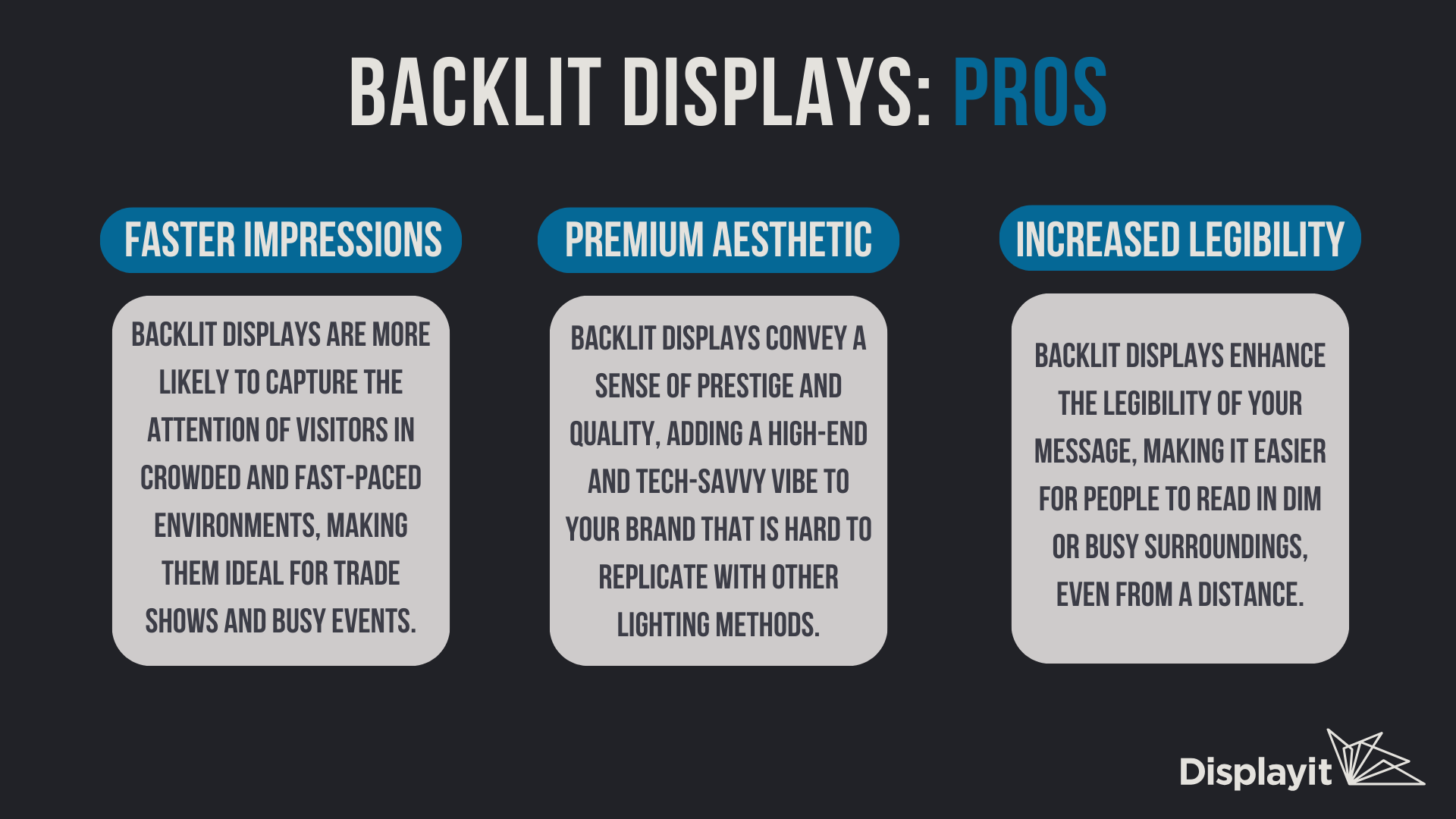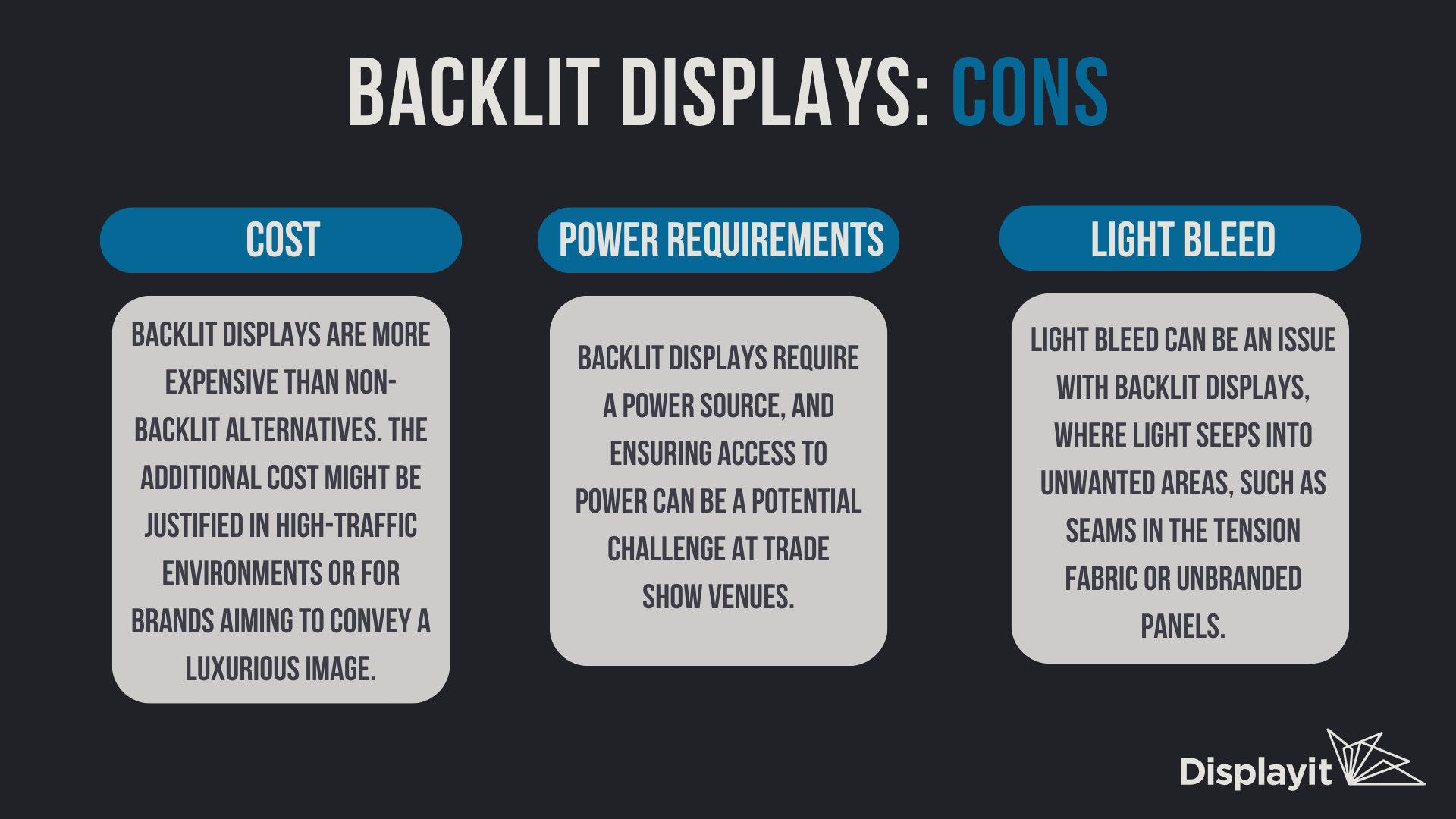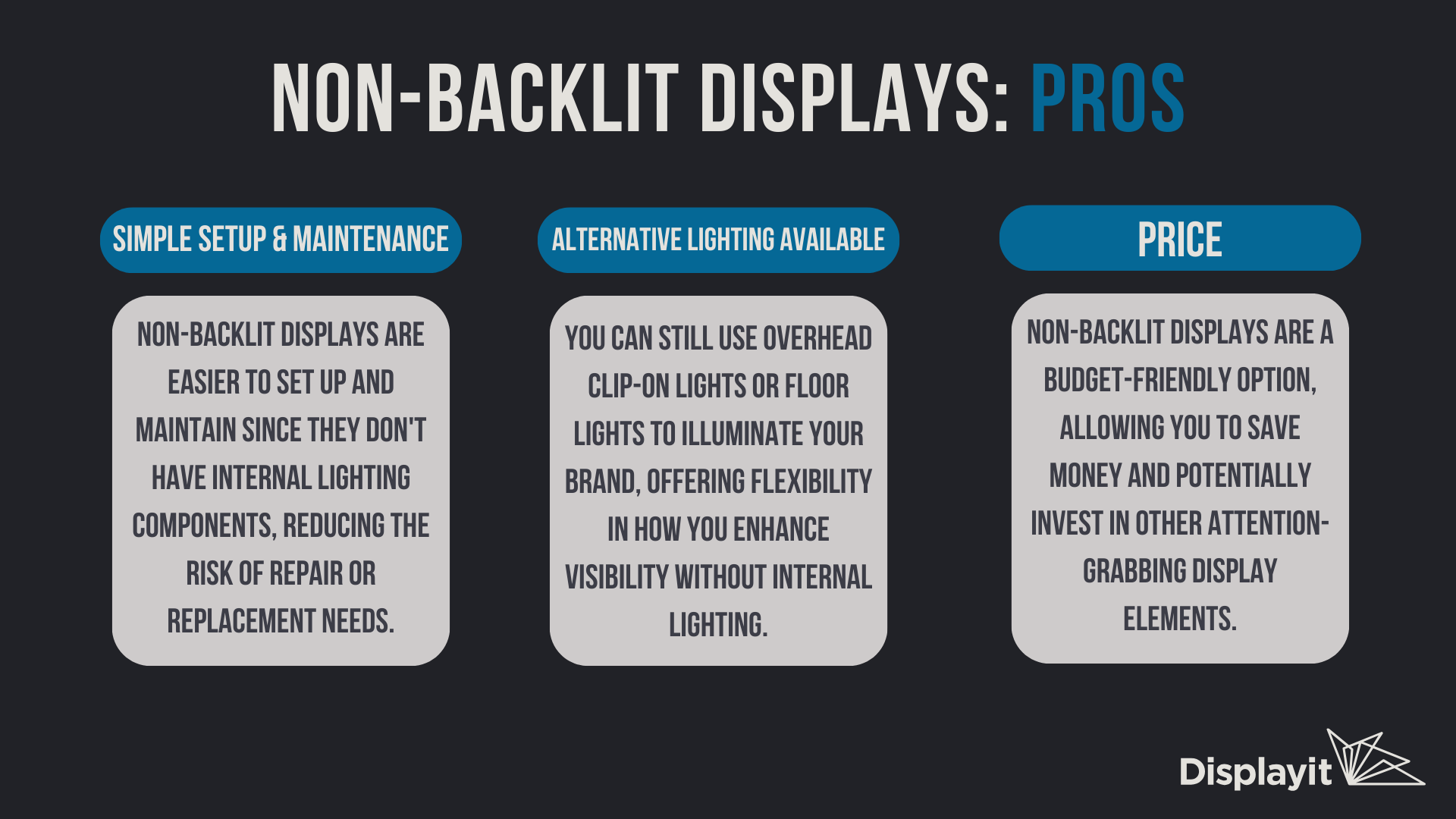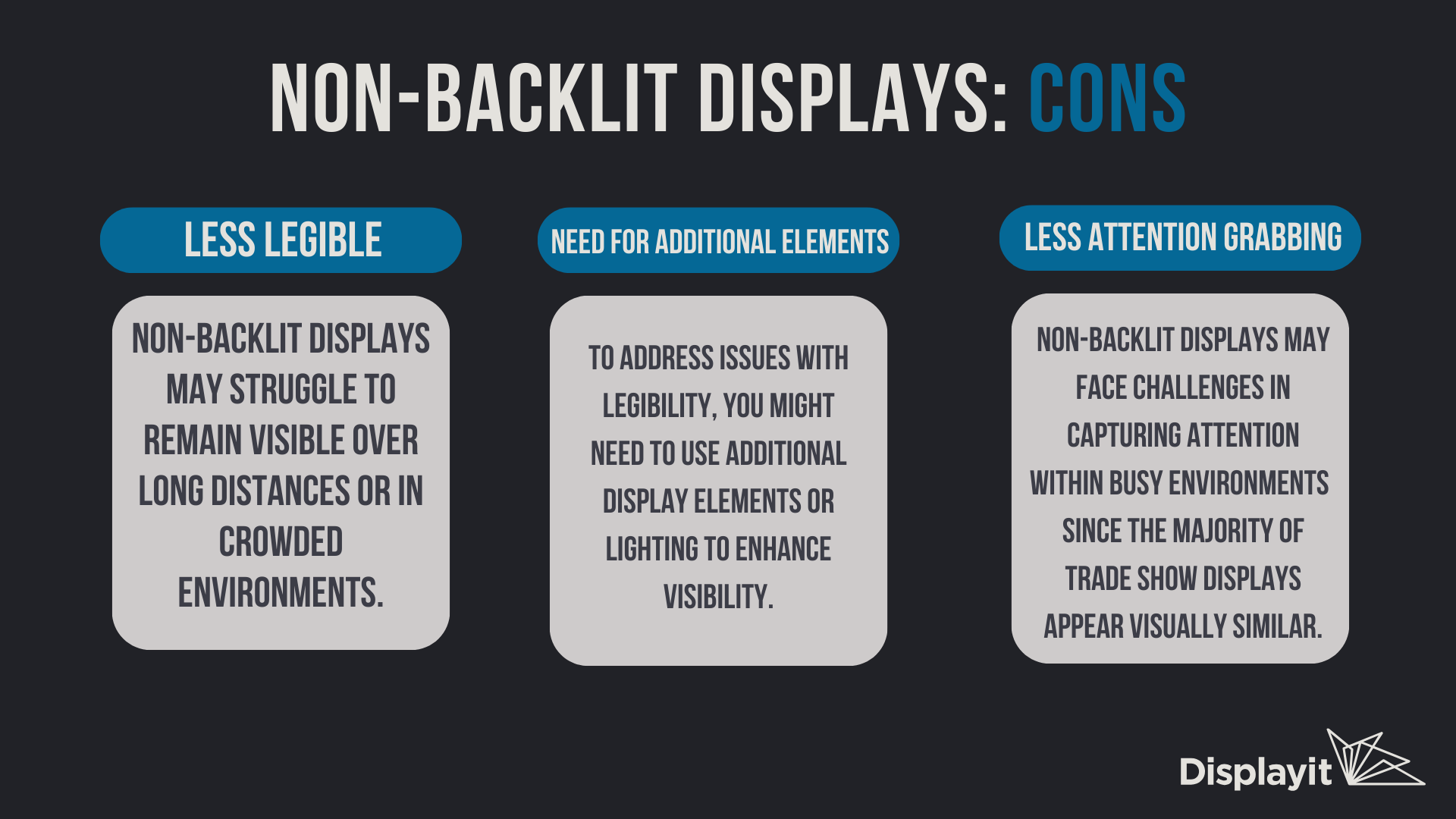If you’ve ever been to a trade show, you already know the difference: there are the regular displays, banner stands, counters, and other display arrangements that you can expect at pretty much any event across the country—but every once in a while, one of the displays you’re looking at will appear to glow. From a distance, you might not be sure what you’re looking at: an LED wall? Another sort of screen? A digital projection?
Odds are you’re looking at a backlit display—a hollow display frame with a print stretched around it, with the display’s graphic lit from the inside. They’re one of the hottest items in the trade show display world, and here, we’ll walk you through what they are, how they work, and what their advantages and disadvantages are when compared to non-backlit, or ‘traditional’, displays.
What Are Backlit Displays?
To understand how a backlit trade show display works, you’ve got to get an idea of the architecture behind the average display. Most higher-end trade show displays use a frame and tension fabric system that stretches a custom visual over a metal support structure—the interior of that structure, though, remains hollow.
In the case of a backlit display, a specially designed array of LED lights fills that hollow space. It’s not quite as simple as putting a single light up in the middle or on the sides of your display—with a quality backlit display, the LED lights will be arranged in such a way as to provide an even glow without giving off a pattern of lit and unlit space.
The fabric itself, too, is specially made from a material that lets light through just how it needs to, without letting a bunch of light escape from the seams on the back or side of the display. The result is a smooth-edged box with a seamless interior glow—your brand, all up in lights. What’s not to like?
Alternative Lighting Options
There are other ways to add light to your display, of course: some businesses use floor lights, lamps, or other practical lighting solutions, but depending on the light source, this might give you a harsher, shadow-prone light that feels inconsistent. A more common solution is clip-on overhead lights, which attach to the top of your display frame and illuminate your print that way.
Clip-on lights are a good way to illuminate your display space, but they still leave some opportunity for shadows, uneven/harsher lighting, and may not have enough ‘reach’ to light up every corner of the display. The end result might emphasize your visuals in contrast to their surroundings, but it won’t have the same ‘high-end’ feel you’ll get with backlighting.
On the other hand, you can always light up your display with something even more bombastic and dynamic: monitor mounts and LED walls, but that’s another story. For now, let’s take a deeper look at what separates most backlit and non-backlit displays.
Backlit Displays: Pros & Cons
Backlit trade show displays are a great solution for businesses hoping to convey a sleek, future-focused brand, especially in a crowded environment—but as with everything, a backlit display will have its advantages and disadvantages. Here’s a breakdown of what could inform this choice for you:
Pros

- Faster Impressions: Trade shows (and other events where you might be exhibiting) are naturally busy, crowded affairs where the whole point is to get the attention of visitors who could easily be overwhelmed, tired, or otherwise exhausted. In high-intensity environments like that, a lit display is more likely to garner someone’s attention in their split-second observations of the event space.
- Increased Legibility: Beyond getting people’s attention, a lit display is a better way to convey a message due to its increased legibility: it’s simply easier for people to read a backlit display in dim or busy environments than a non-lit one. If you have a more complex message, more text, or branding that’s especially detailed and refined, it might be a good idea to use backlighting to give people a better chance of understanding the message even from farther away.
- Premium Aesthetic: Any display can be lit up, but a backlit display conveys a sense of prestige and quality that’s hard to replicate. When compared to displays lit by floor lights or overhead lights, the difference is just night and day.
Cons

- Cost: No getting around it—backlit displays are more expensive than their non-backlit counterparts. Still, a backlit display can be worth the cost for brands in exceptionally busy environments or those looking to convey a high-end or ‘techy’ feel, but businesses on a budget could still get everything they need for a display without backlighting.
- Power Requirements: Trade show venues usually do a great job of ensuring exhibitors’ access to power—but, as with anything, you might get a curveball. On top of that, if you’re assembling a display yourself, you’ll just have a few extra steps to ensure that power is running to the right places and that your display’s set up correctly. A quality display makes set-up easy, but access to power will always be one more thing to consider.
- Light Bleed: With a backlit display, light bleed is always something to consider. This refers to when light seeps into places where it’s not wanted: out through seams in the tension fabric and onto other parts of the display, or out onto panels of the fabric print that don’t have custom branding on them. A quality display will have fabric designed to concentrate all light only through the specially-printed sides of the display.
Product Examples
- Prism: Our highest-end backlit display line—Prism kits and display elements are constructed using our best fabric over solid aluminum steel frames.
- Graffiti:Plus: Our mid-level line of backlit trade show displays includes everything you’d need for a standout performance at your next event!
- Ensemble: Our Ensemble line of backlit displays is modular, including display elements and accessories that can easily be mixed and matched to create unique display arrangements that work perfectly for you.
Non-Backlit Displays: Pros & Cons
Even with backlit displays in the picture, non-backlit displays still certainly have their place in the display world. They don’t feature internal lighting, but they can still be lit in other ways, and for any brand hoping to put on a show with a lower budget, they may be the best option.
Pros

- Simple Setup & Maintenance: No LED array means one less step during setup and one less piece of the display that could need replacement or repair. Even our backlit displays can be assembled without tools, but if you’re trying to streamline the setup process, it’s one less thing to think about.
- Alternative Lighting Options Available: Just because you go with a non-backlit display doesn’t mean you can’t have your brand up in lights! Overhead clip-on lights and floor lights are still perfectly acceptable ways to increase your branding’s visibility at an event.
- Price: On a budget? A non-backlit display might be the best option for you. Saving money by skipping out on backlighting might also open the door to adding other display elements and accessories that will draw attention to your booth.
Cons

- Less Legible, Less Attention-Grabbing: Over a long distance, or in an otherwise crowded, busy space, your display may have a harder time getting people’s attention and retaining it. Again, expanding your display through the use of multiple display elements or other lighting elements can help you if you’re having trouble with this.
Product Examples
- Graffiti:Our standard Graffiti line includes all the benefits of the Graffiti:Plus display line, just without the backlighting.
- Ensemble: You can still benefit from the modular design of our Ensemble line without paying more for backlit displays.
- Banner Stands & Accessories:On top of the lines above, there are plenty of standalone display products and accessories that just don’t have backlighting: outdoor flags, retractable banner stands, and counter add-ons fit into this category.
Alternative Lighting Options: Monitor Mounts & LED Walls
As mentioned previously, you can always add light to your displays without using backlighting. There are overhead lights that can be clipped on, floor lights that can be set up, and of course, there are always lamps or other lighting accessories that can add that much more visual flair to your trade show booth.
Beyond that though, there are still a couple more options to consider if you want a well-lit display: monitors (computer/TV screens) and LED Walls.
Pros
- Dynamic Visuals: If you add monitor mounts to your display (or choose a higher-end display with integrated LED walls), you can set up screens that show off your digital media: slideshows, videos, even interactive media, all of which add another dimension to your display experience.
Cons
- Not All-in-One: With a trade show booth and monitor, the main ‘con’ is not having everything in a single, concise package, like you get with a backlit display that has an LED array already integrated. Monitors and LED walls both require preparing media off-site for your event date, and monitors themselves are one more physical item to transport and set up.
Product Examples
- Monitor Mounts:Monitor mounts are yet another way to add something dynamic and visual to your display frame
- LED Wall Displays:Looking for the biggest and baddest displays available? Our High Impact Displays brand offers rental displays with LED Walls of many different sizes
Backlit vs. Non-Backlit: Made Your Pick?
If you want to check out our displays and see the products we’ve got on offer (backlit and non-backlit included!) we’ve got plenty available for purchase on our online store.
OR



